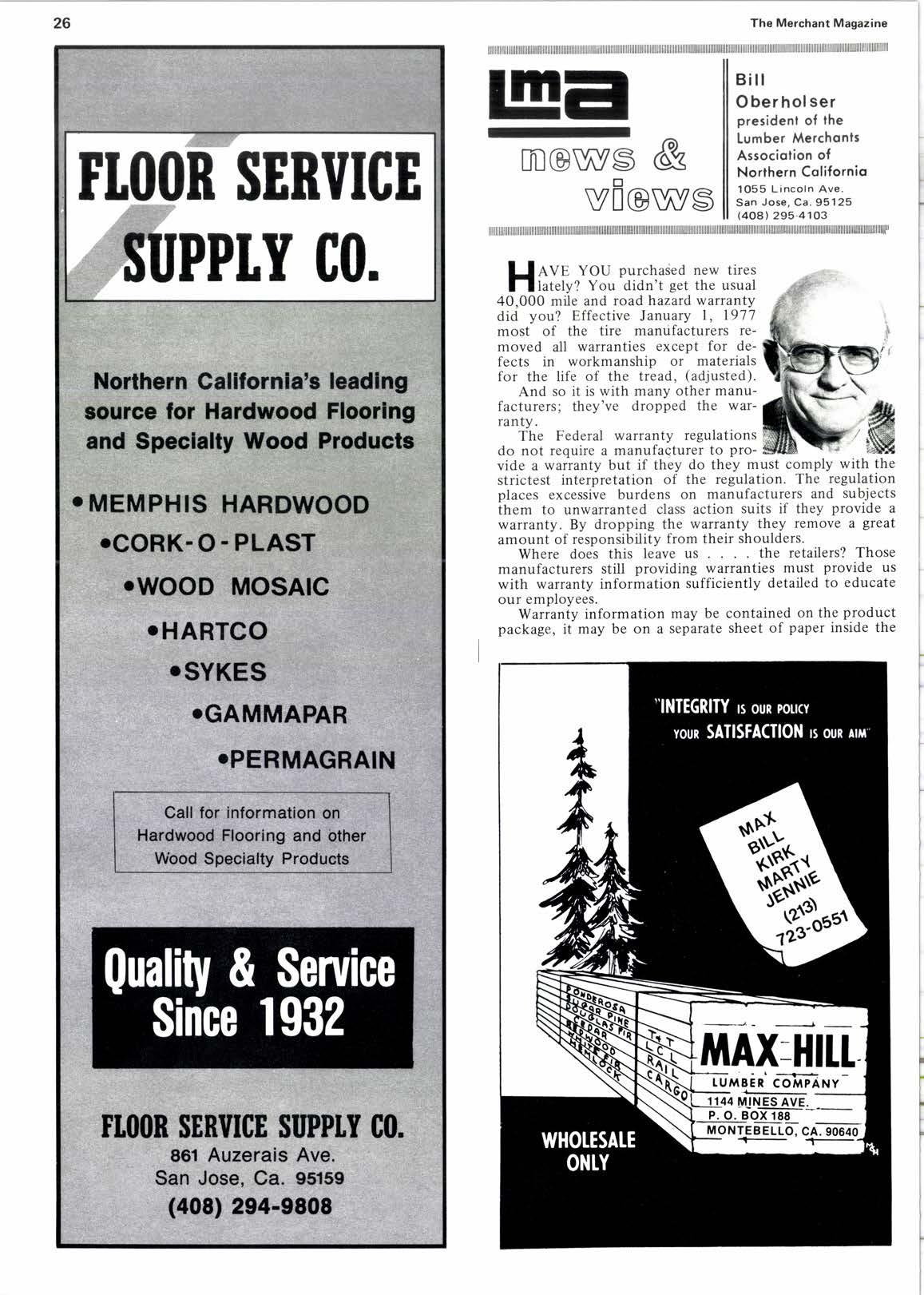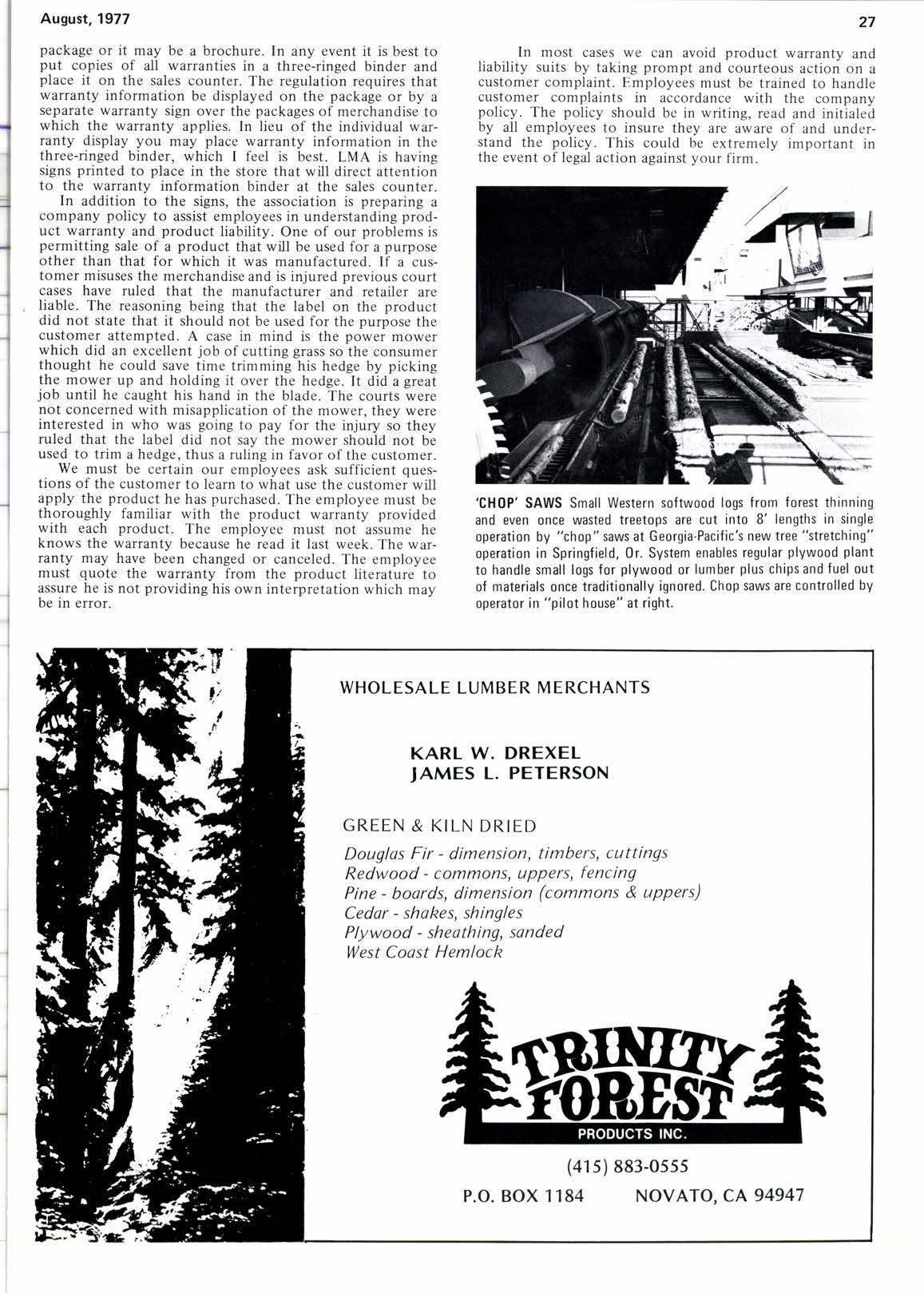
3 minute read
Itre
r6t aon4-we
/;<,/
LJLJ Tt7 W E) L9-5 E
,,ir i iLlrl lll lil lll Li,ri ;
Birl
O ber hol ser president of the Lumber Merchonls Associolion of Northern Colifornio 1055 Lrncoln Ave San Jose, Ca.95125 (40a) 295 4103 tillilli
Ll ,rrt r, \'oLr pr.rrchascd ncr.r, tire s
I I latcl-v'l Yor,r didn't gct tltc usttrl
'+0.000 nrilc and road hazard warrrnty dicl -vcru'l []i'le ctive January l, 1911 rlost oi the lire nranulactltte rs rcnroved all lvlrrranties cxcc[)t tor r'lcfects in rvorknranship ol trtateriels fhe Fcclerll \\'arr-anly regulatiotts tlo not requlfa a rttrnttllcturer to pro- 3 vitic r u'arranty but il tltcy do thcy tnttst corttply \\'lth tlle stricttst interprctatiotl ()i the rcgLtlation. l hc regulation pleces cxcessive trutclctts on matrtlftctttttts atld sttbjccts lhcnr to Lrnlvarrantccl class action suits il they providc a wilrranty. B-v dropping tht \\'arranty tllcy rcnt<lve a grcat anrount ol responsibility iront their shor-rldcrs.
1or thc lii'e ot thc tread. {ad.iuslcd).
And so jt is ri'ith ntanl olher lttarttt1ac1r,rrers. th.!'vc droppcd thc warralrty.
Whcre does this lcavt us the retailers'l Those nranutacturers still providing warrauties ntust provide us rvith rvarranty information su1'ficiently detailed to educate our cnlployees.
Warranty information ttray be contalned on the product packagc, it may be on a scparate sheet of paper inside the package or it may be a brochure. In any event it is best to put copies of all warranties in a three-ringed binder and place it on the sales counter. The regulation requires that warranty information be displayed on the package or by a separate warranty sign over the packages of merchandise to which the warranty applies. In lieu of the individual warranty display you may place warranty information in the three-ringed binder, which I feel is best. LMA is having signs printed to place in the store that will direct attention to the warranty information binder at the sales counter.
In addition to the signs, the association is preparing a company policy to assist employees in understanding product warranty and product liability. One of our problems is permitting sale of a product that will be used for a purpose other than that for which it was manufactured. If a customer misuses the merchandise and is injured previous court cases have ruled that the manufacturer and retailer are liable. The reasoning being that the label on the product did not state that it should not be used for the purpose the customer attempted. A case in mind is the power mower which did an excellent job of cutting grass so the consumer thought he could save time trimming his hedge by picking the mower up and holding it over the hedge. It did a great job until he caught his hand in the blade. The courts were not concerned with misapplication of the mower, they were interested in who was going to pay for the injury so they ruled that the label did not say the mower should not be used to trim a hedge, thus a ruling in favor of the customer.
We must be certain our employees ask sufficient questions of the customer to learn to what use the customer will apply the product he has purchased. The employee must be thoroughly familiar with the product warranty provided with each product. The employee must not assume he knows the warranty because he read it last week. The warranty may have been changed or canceled. The employee must quote the warranty from the product literature to assure he is not providing his own interpretation which may be in error.
In most cases we can avoid product warranty and liability suits by taking prompt and courteous action on a customer complaint. E,mployees must be trained to handle customer complaints in accordance with the company policy. The policy should be in writing, read and initialed by all employees to insure they are aware of and understand the policy. This could be extremely important in the event of legal action against your firm.
'CH0P' SAWS Small Western softwood logs from forest thinning and even once wasted treetops are cut into 8' lengths in single operation by "chop" saws at Georgia-Pacific's new tree "stretching" operation in Springfield, 0r. System enables regular plywood plant to handle small logs for plywood or lumber plus chips and fuel out of materials once traditionally ignored. Chop saws are controlled by operator in "pilot house" at right.
Douglas Fir - dimension, timbers, cuttings

Redwood - commons, uppers, fencing Pine - boards, dimension (commons & uppers)
Cedor - shakes, shingles
Plywood - sheathing, sanded West Coast Hemlock










